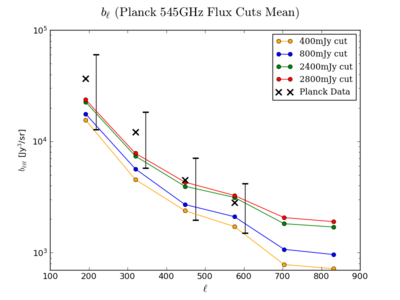Nov 13th, 2019 - Scaling the Bispectra Using Different Flux Cuts & Power Spectra Sanity Check
Jump to navigation
Jump to search
As we were discussing last week, by raising the flux cut and replacing the cut-out pixels with the flux cut value rather than the mean of the map, I was able to scale the Websky bispectra closer to Planck's observed values. In this post, the analysis was done on the 545GHz map.
The first two figures show the comparison between Planck and Websky bispectrum values for 400mJy, 800mJy, 2400mJy, and 2800mJy flux cuts. The left plot was produced using the mean (of the map) to replace the cut-out pixels. The right figure shows the difference between mean-replaced and flux cut value-replaced maps for each flux cut.
We first see that raising the flux cut raises the bispectrum as well, but the rise seems to be higher for higher [math]\displaystyle{ \ell }[/math]. Using the flux cut value to replace the cut out pixels also raises the bispectrum substantially and this rise seems to have a noticeable [math]\displaystyle{ \ell }[/math] dependence for the higher flux cuts and a small, but still visible [math]\displaystyle{ \ell }[/math] dependence for the lower flux cuts. Because of the [math]\displaystyle{ \ell }[/math] dependence in the rise for both cases, the 2800mJy cut (replaced with the flux-cut value) has a bispectrum very close to Planck values on average, but the first two data points are smaller while the middle two points are larger than Planck values. This is the point where I stopped (higher flux cuts, especially for the flux-cut value replaced map seem unnecessary).
Since we had seen from George's plot comparing Planck and Websky power spectra that the two data now match very well at 545GHz (with a 350mJy or 400mJy flux cut imposed), I plotted the power spectra of 545GHz maps with the various flux cuts (using the flux-cut value-replaced map) hoping that the power spectra do not change too much.
We see that the Planck and Websky power spectra start to diverge at [math]\displaystyle{ \ell \gt 1000 }[/math] for the higher flux cuts. Interestingly enough however, the bispectra values Planck measured were at [math]\displaystyle{ \ell = 192, 320, 448, 576, 704 }[/math], where the power spectra between Planck and Websky still match very well for all of the flux cuts. In fact, it seems that the Websky power spectra of the 2400 and 2800 mJy cuts match Planck's a bit better than the lower flux cut maps.
Thus, it may be optimal to use the 2400 or 2800mJy flux cut maps (for 545GHz) at [math]\displaystyle{ \ell \lt 1000 }[/math] for both the bispectra and the power spectra. The key now is to find out why the scaling could be necessary.


